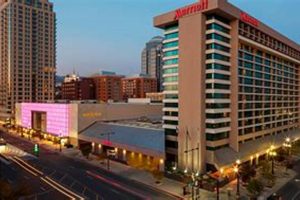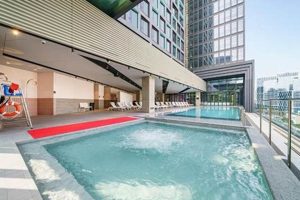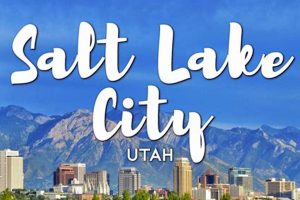Salt Lake City, Utah’s capital and largest city, offers a unique blend of urban and natural attractions. Visitors can explore a vibrant downtown area alongside stunning mountain vistas and the vast expanse of the Great Salt Lake. Experiences range from historical landmarks and world-class museums to outdoor adventures like hiking, skiing, and exploring the unique ecosystem of the lake itself.
The city’s location at the foot of the Wasatch Mountains and its historical significance as the center of the Church of Jesus Christ of Latter-day Saints contribute to its rich cultural tapestry. This provides visitors with opportunities to learn about the region’s history, art, and diverse communities. Access to the natural wonders surrounding the city promotes healthy lifestyles and provides a respite from urban environments. Exploring these features contributes significantly to the city’s tourism industry and boosts the local economy.
This exploration delves into the various attractions available within Salt Lake City, categorizing them by interest and providing details on their historical significance, accessibility, and what visitors can expect.
Tips for Exploring Salt Lake City
Careful planning enhances any visit to Salt Lake City. These tips offer guidance for maximizing enjoyment and navigating the city’s diverse offerings.
Tip 1: Consider the season. Salt Lake City experiences distinct seasons, each offering unique activities. Winter provides access to world-class skiing, while summer is ideal for hiking and exploring the Great Salt Lake.
Tip 2: Utilize the public transportation system. The TRAX light rail system and bus network provide efficient and affordable transportation throughout the city and surrounding areas, reducing the need for a car.
Tip 3: Allocate sufficient time for Temple Square. This historic site requires several hours to fully appreciate its architecture, gardens, and cultural significance.
Tip 4: Explore beyond the city center. The natural beauty surrounding Salt Lake City, including canyons and hiking trails, offers a welcome contrast to the urban environment. Consider day trips to nearby destinations.
Tip 5: Pack for varied weather conditions. Mountain weather can change rapidly, so layering clothing is advisable, even during warmer months.
Tip 6: Research events and festivals. Salt Lake City hosts numerous events throughout the year, from music festivals to farmers’ markets. Checking local listings can enhance a visit.
Tip 7: Reserve accommodations and tours in advance, especially during peak season. This ensures availability and can often result in better rates.
Following these tips can contribute to a more rewarding and memorable experience in Salt Lake City, allowing visitors to fully appreciate its unique blend of cultural and natural attractions.
By considering these suggestions, visitors can create personalized itineraries suited to their interests and make the most of their time in this dynamic city.
1. Temple Square
Temple Square stands as a prominent landmark and a central component of any exploration of Salt Lake City’s key attractions. Its historical and cultural significance as the headquarters of The Church of Jesus Christ of Latter-day Saints draws millions of visitors annually, contributing substantially to the city’s tourism. The meticulously maintained grounds, iconic temple, and surrounding historical buildings offer a glimpse into the city’s founding and religious heritage. This historical context provides visitors with an understanding of the city’s development and the influence of the Church.
Temple Square’s role as a hub for religious and cultural activities extends beyond its historical significance. Free tours, performances by the Tabernacle Choir at Temple Square, and seasonal displays like the Christmas lights create a dynamic and engaging experience for visitors of diverse backgrounds and interests. The readily available information centers and multilingual resources offered facilitate accessibility and understanding for a global audience. This accessibility contributes to Temple Square’s appeal and reinforces its position as a must-see destination within Salt Lake City.
Understanding the connection between Temple Square and Salt Lake City’s appeal enhances the visitor experience. Recognizing its historical and ongoing cultural importance allows visitors to connect with the city on a deeper level. While the temple itself is not open to the public, the surrounding grounds, visitor centers, and historical exhibits provide ample opportunity for exploration and reflection. This understanding underscores the significance of Temple Square not merely as a tourist attraction, but as a vital component of Salt Lake City’s identity and cultural landscape.
2. Great Salt Lake
The Great Salt Lake, a remnant of prehistoric Lake Bonneville, represents a significant natural landmark integral to understanding Salt Lake City and its surrounding environment. Its unique ecosystem, historical relevance, and recreational opportunities position it as a key attraction for visitors. Exploration of the lake provides insights into geological history, ecological adaptations, and the interplay between natural and urban landscapes.
- Ecological Significance
The hypersaline environment of the Great Salt Lake supports a unique ecosystem, featuring brine shrimp and migratory birds. This delicate balance plays a vital role in the regional food chain and provides critical habitat for several endangered species. Observing this unique ecosystem offers visitors an opportunity to appreciate the complexities of natural adaptation and the importance of conservation efforts.
- Recreational Opportunities
The lake offers diverse recreational activities, including sailing, kayaking, and birdwatching. The surrounding wetlands and state parks provide hiking trails and opportunities for wildlife viewing. These activities contribute to Salt Lake City’s appeal as a destination for outdoor enthusiasts and provide avenues for experiencing the natural beauty of the region.
- Historical Context
The Great Salt Lake holds historical significance, particularly concerning its role in the westward expansion of the United States. Spiral Jetty, a prominent earthwork sculpture, exemplifies the intersection of art and landscape within the context of the lake. Understanding this historical context enriches the visitor experience and provides a deeper appreciation for the region’s complex past.
- Impact on Local Climate
The lake’s vast surface area influences local weather patterns, impacting snowfall in the Wasatch Mountains, a crucial resource for the region’s water supply and ski industry. This interplay between natural features highlights the interconnectedness of the environment and its impact on human activities, emphasizing the importance of sustainable practices and resource management.
The diverse facets of the Great Salt Lake, from its ecological significance to its historical context, contribute substantially to its position as a must-see destination in Salt Lake City. Experiencing the lake provides visitors with a broader understanding of the region’s natural and cultural heritage, enhancing their appreciation for the interplay between urban development and the preservation of natural wonders. This understanding positions the Great Salt Lake not merely as a standalone attraction but as a critical component of the Salt Lake City experience.
3. Natural History Museum of Utah
The Natural History Museum of Utah (NHMU) ranks among Salt Lake City’s premier attractions, offering valuable insights into the region’s rich natural and cultural heritage. Situated at the foothills of the Wasatch Mountains, the museum’s location complements its focus on the natural world, providing visitors with a seamless transition between the exhibits and the surrounding environment. Its inclusion among the “best things to see” stems from its comprehensive collections, engaging exhibits, and its contribution to understanding the interconnectedness of the region’s past, present, and future.
- Past Worlds
The NHMU’s paleontology exhibits showcase Utah’s remarkable dinosaur discoveries, placing the state on the global map for paleontological research. From the towering skeletons of sauropods to the intricate details of fossilized plants, these exhibits offer a glimpse into prehistoric life and the geological forces that shaped the landscape. This deep time perspective contextualizes the present environment and emphasizes the dynamic nature of the natural world.
- First Peoples
Exhibits dedicated to the history and cultures of Utah’s Native American tribes offer crucial insights into human interactions with the environment over millennia. These displays highlight the diverse traditions, lifeways, and enduring connection between indigenous peoples and the land, adding a vital layer of cultural understanding to the museum’s exploration of natural history.
- Sky
The museum’s astronomy and space science programs connect Utah’s natural landscapes to the broader universe. Promoting understanding of celestial phenomena and scientific exploration, these programs utilize Utah’s dark skies as a natural resource for observation and learning, showcasing the interconnectedness of local environments and the cosmos.
- Land
Exhibits exploring Utah’s diverse ecosystems, from the Great Salt Lake to the alpine forests of the Wasatch Mountains, emphasize the delicate balance of nature and the impacts of human activity. Visitors gain an appreciation for the complex web of life within these environments and the ongoing efforts to preserve them for future generations. This focus on current ecological challenges connects the museum’s historical narratives to contemporary issues of sustainability and conservation.
The NHMUs comprehensive approach to natural history, encompassing past worlds, human cultures, and contemporary ecological concerns, solidifies its position as a key destination in Salt Lake City. By offering engaging exhibits and educational programs, the museum provides visitors with a deeper understanding of Utah’s unique place within the broader natural world, enriching their experience and promoting appreciation for the intricate connections between the environment, culture, and scientific exploration. It stands as a vital resource for understanding the past, appreciating the present, and shaping a sustainable future.
4. Gilgal Sculpture Garden
Gilgal Sculpture Garden offers a unique and thought-provoking experience, distinguishing it among Salt Lake City’s attractions. Its inclusion among the “best things to see” stems from its unusual blend of art, philosophy, and religious symbolism, creating an environment that encourages contemplation and personal interpretation. This hidden gem provides a distinct contrast to the city’s more traditional attractions, offering visitors a glimpse into the vision of its creator, Thomas Battersby Child, Jr.
- Artistic Expression and Symbolism
The garden’s central theme revolves around self-discovery and spiritual exploration, expressed through a collection of enigmatic sculptures and inscribed stones. These works, crafted by Child between 1945 and 1963, incorporate biblical imagery, literary references, and philosophical concepts, encouraging viewers to engage with their own interpretations of the symbolism. The sphinx with the head of Joseph Smith, a prominent figure in Mormonism, exemplifies this blend of religious and artistic expression.
- Hidden Gem and Local Significance
Tucked away in a residential neighborhood, Gilgal Sculpture Garden offers a sense of discovery and peaceful respite from the urban environment. Its status as a hidden gem contributes to its unique appeal, attracting those seeking unconventional experiences. The garden’s existence reflects the city’s capacity to embrace unique forms of artistic expression and its value as a space for quiet reflection within a bustling urban setting.
- Accessibility and Community Engagement
Gilgal Sculpture Garden’s free admission and accessible design make it an inclusive space for diverse audiences. Its intimate setting and unique character foster community engagement and provide a platform for local artists and events. This accessibility contributes to its value as a community asset and its relevance to a broad range of visitors.
- Historical and Cultural Context
As a reflection of Child’s personal beliefs and artistic vision, the garden offers insights into the cultural and religious landscape of mid-20th-century Salt Lake City. Understanding the historical context surrounding its creation adds another layer of interpretation to the sculptures and their symbolism. The garden serves as a tangible representation of individual expression within a specific historical and cultural setting.
Gilgal Sculpture Garden’s blend of artistic expression, historical context, and community engagement contributes to its significance within the landscape of Salt Lake City attractions. It stands as a testament to the power of individual vision and its potential to enrich the cultural fabric of a city. By offering visitors a space for contemplation and personal interpretation, Gilgal Sculpture Garden provides a unique and memorable experience that distinguishes it among the “best things to see” in Salt Lake City. Its unconventional nature and focus on introspection create a lasting impact, inviting visitors to explore the intersection of art, philosophy, and personal meaning within the context of a vibrant urban environment.
5. Utah State Capitol Building
The Utah State Capitol Building’s prominence on any list of “best things to see in Salt Lake City” stems from its architectural grandeur, historical significance, and symbolic representation of state government. Its location overlooking the city provides a visual reminder of its role in Utah’s civic life. The building’s neoclassical design, inspired by the national capitol, reflects the state’s aspirations and its connection to the broader American political landscape. This architectural significance, coupled with its functional role as the center of state government, positions the Capitol Building as a key destination for visitors seeking to understand Utah’s history and political processes.
The Capitol Building’s importance extends beyond its architectural and governmental functions. Its accessibility to the public, through free guided tours and open legislative sessions, provides opportunities for civic engagement and education. Visitors can observe the legislative process firsthand, explore historical exhibits detailing Utah’s statehood and development, and appreciate the artistic details within the building, such as the murals depicting scenes from Utah’s history and the intricate craftsmanship of the interior design. These opportunities for engagement and education contribute to the building’s value as a cultural and historical resource, enriching the visitor experience and fostering a deeper understanding of state government.
Understanding the Capitol Building’s significance enhances appreciation for its place among Salt Lake City’s top attractions. Recognizing its architectural, historical, and functional roles allows visitors to connect with the city’s civic identity and the broader narrative of Utah’s development as a state. This understanding strengthens the connection between the Capitol Building and tourism, contributing to Salt Lake City’s appeal as a destination for those interested in exploring the intersection of history, architecture, and government. Its position overlooking the city serves as a constant reminder of its importance, inviting exploration and fostering a deeper appreciation for the processes that shape Utah’s present and future.
6. Red Butte Garden
Red Butte Garden’s inclusion among the “best things to see in Salt Lake City” stems from its unique blend of natural beauty, educational opportunities, and cultural enrichment. As a botanical garden and arboretum situated at the base of the Wasatch Mountains, it offers visitors a diverse experience encompassing horticultural displays, educational programs, and artistic performances. This multifaceted approach positions Red Butte Garden as a destination catering to a wide range of interests, contributing significantly to Salt Lake City’s appeal as a vibrant and culturally rich city.
- Horticultural Diversity and Display
Red Butte Garden’s extensive collections showcase a diverse range of plant life, from native Utah flora to exotic species from around the world. Themed gardens, such as the Water Conservation Garden and the Herb Garden, provide specific examples of horticultural practices and plant adaptations. These displays offer visitors insights into botany, ecology, and the art of garden design, enriching their understanding of the natural world and its intersection with human cultivation.
- Educational Programs and Community Engagement
Red Butte Garden plays a vital role in community education through classes, workshops, and outreach programs focused on horticulture, conservation, and environmental awareness. These initiatives provide opportunities for lifelong learning and community engagement, fostering a deeper appreciation for the natural world and promoting sustainable practices. The garden’s educational programs extend its impact beyond its physical boundaries, contributing to environmental stewardship and community enrichment within Salt Lake City.
- Cultural Events and Artistic Performances
Red Butte Garden serves as a venue for various cultural events, including concerts, art exhibitions, and seasonal festivals. The outdoor amphitheater provides a unique setting for musical performances, enhancing the cultural landscape of Salt Lake City and offering visitors a blend of artistic and natural experiences. These events contribute to the garden’s vibrancy and its appeal as a destination for entertainment and cultural enrichment.
- Conservation Efforts and Environmental Stewardship
Red Butte Garden’s commitment to conservation is reflected in its research programs, water conservation initiatives, and sustainable gardening practices. These efforts contribute to preserving plant biodiversity and promoting environmentally responsible practices within the community. The garden’s role in conservation aligns with broader environmental concerns and highlights the importance of sustainable resource management within urban environments like Salt Lake City.
Red Butte Garden’s diverse offerings, encompassing horticultural displays, educational programs, cultural events, and conservation efforts, solidify its position as a key attraction within Salt Lake City. Its ability to cater to a broad range of interests, from botany enthusiasts to art lovers, contributes to the city’s appeal as a dynamic and culturally rich destination. By fostering appreciation for the natural world, promoting community engagement, and providing opportunities for cultural enrichment, Red Butte Garden enriches the visitor experience and enhances the overall quality of life within Salt Lake City.
Frequently Asked Questions
This section addresses common inquiries regarding visiting Salt Lake City, providing concise and informative responses to assist in planning and maximizing the visitor experience. Clarity on these points often enhances enjoyment and facilitates informed decision-making.
Question 1: How many days are recommended for exploring Salt Lake City’s key attractions?
A minimum of three to four days allows adequate time to experience core attractions like Temple Square, the Great Salt Lake, and the Natural History Museum of Utah. Extending the stay allows for deeper exploration of specific interests, such as hiking in nearby canyons or visiting additional museums.
Question 2: What is the best time of year to visit Salt Lake City?
The optimal time depends on individual preferences and planned activities. Summer offers warm weather suitable for outdoor activities, while winter provides access to world-class skiing. Spring and fall offer pleasant temperatures and fewer crowds, making them ideal for sightseeing and exploring the city’s cultural attractions.
Question 3: Is a car necessary for navigating Salt Lake City?
While a car offers flexibility, Salt Lake City possesses a reliable public transportation system, including the TRAX light rail and a comprehensive bus network. Utilizing public transport reduces the need for parking and allows efficient access to many key destinations.
Question 4: Are there free activities available in Salt Lake City?
Numerous free activities are available, including exploring Temple Square, visiting the Gilgal Sculpture Garden, hiking in nearby canyons, and attending free events at local parks and community centers. Leveraging these free options contributes to an affordable and enriching experience.
Question 5: What are the dining options in Salt Lake City?
Salt Lake City offers a diverse culinary scene, ranging from upscale restaurants to casual eateries. Exploring local farmers’ markets and ethnic neighborhoods provides opportunities to sample regional specialties and international cuisines. Options cater to various budgets and dietary preferences.
Question 6: What should visitors be aware of regarding altitude sickness in Salt Lake City?
Salt Lake City’s elevation (approximately 4,300 feet) can cause altitude sickness in some individuals. Staying hydrated, avoiding strenuous activity upon arrival, and allowing time for acclimatization minimizes potential discomfort. Consulting a physician before traveling is advisable for those with pre-existing health concerns.
Addressing these frequently asked questions provides essential information for planning a successful visit to Salt Lake City. Understanding these aspects enhances the visitor experience and allows for a more informed and enjoyable exploration of the city’s diverse attractions.
This concludes the frequently asked questions section. The following sections will offer more in-depth exploration of specific attractions and activities within Salt Lake City.
Best Things to See in Salt Lake City
Exploration of Salt Lake City’s attractions reveals a dynamic interplay between natural wonders, historical significance, and cultural vibrancy. From the majestic peaks of the Wasatch Mountains to the tranquil beauty of Red Butte Garden, the city offers diverse experiences catering to a wide range of interests. Temple Square provides a glimpse into the city’s historical and religious foundations, while the Great Salt Lake offers a unique natural encounter. Cultural institutions such as the Natural History Museum of Utah and the Gilgal Sculpture Garden enrich the visitor experience, providing opportunities for learning and reflection. The Utah State Capitol Building stands as a symbol of civic life, offering insights into the state’s political processes. These diverse offerings combine to create a rich and multifaceted destination.
Salt Lake City’s appeal extends beyond its individual attractions. The city’s unique blend of urban amenities and access to natural landscapes creates an environment conducive to exploration and discovery. Further investigation into the city’s diverse neighborhoods, culinary scene, and thriving arts community promises even greater rewards. Ultimately, experiencing Salt Lake City firsthand provides the most comprehensive understanding of its unique character and enduring appeal.







